Taxation Report on Research and Development Tax Incentives
VerifiedAdded on 2020/05/28
|12
|2935
|34
Report
AI Summary
This report provides a comprehensive analysis of research and development (R&D) tax incentives in Australia. It delves into the significance of these incentives for economic and business development, highlighting advantages such as increased production and improved economic performance. The report categorizes the main tax incentives into refundable and non-refundable tax offsets, detailing eligibility criteria based on company turnover. It explores the tax implications of these incentives, including enhanced business efficiency, improved financial performance, and increased accountability through proper record-keeping. The report also examines relevant tax laws, including the Income Tax Assessment Act 1936 and TR 92/2, outlining conditions for claiming incentives and specifying eligible expenditures. The conclusion emphasizes the role of tax incentives in promoting innovation and societal development, ensuring companies maintain high standards of product quality and contribute to long-term value creation. This report is a valuable resource for understanding the complexities of R&D tax incentives in the Australian context.

Running head: TAXATION
Taxation
Name of Student:
Name of the University:
Authors Note:
Taxation
Name of Student:
Name of the University:
Authors Note:
Paraphrase This Document
Need a fresh take? Get an instant paraphrase of this document with our AI Paraphraser
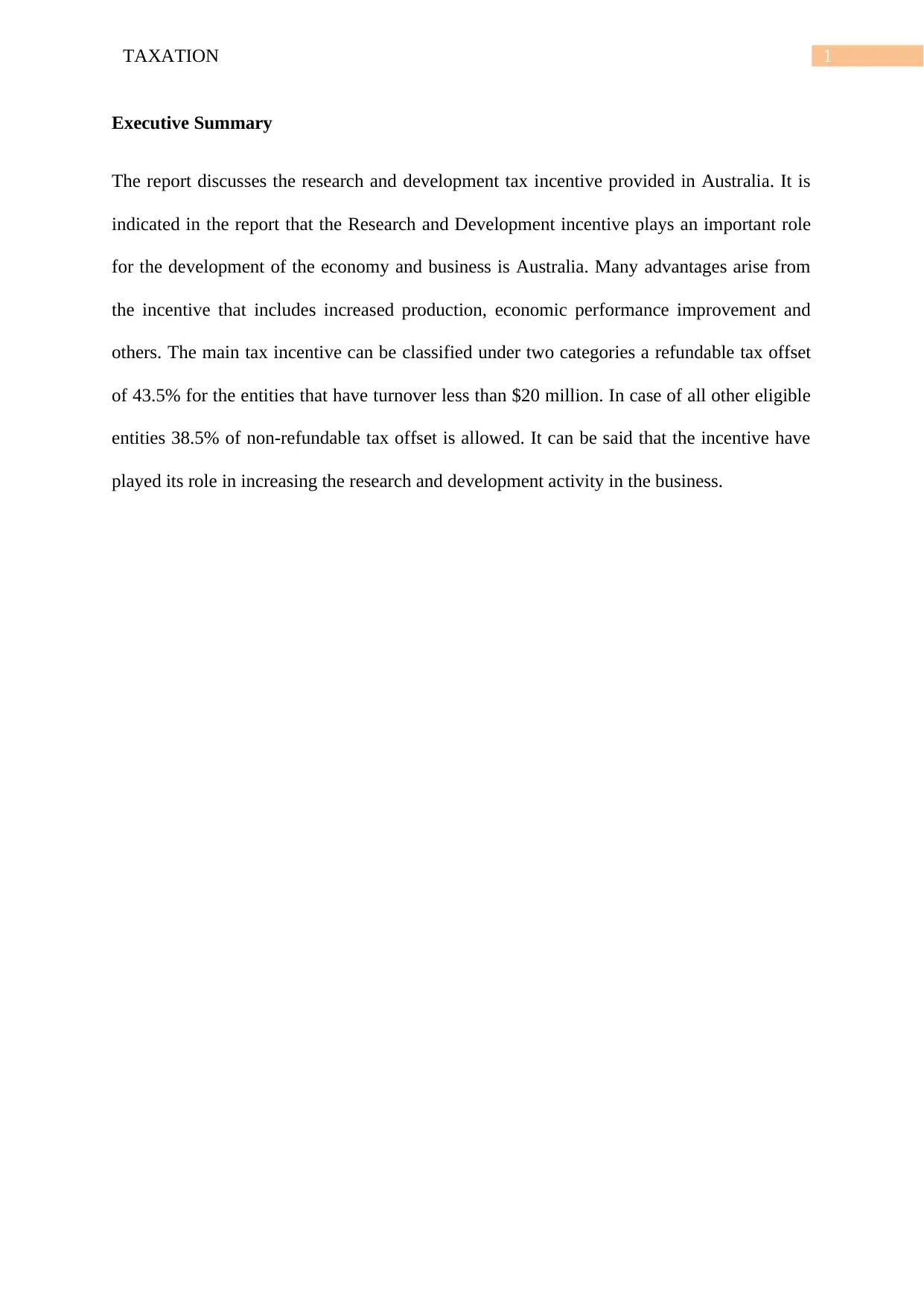
1TAXATION
Executive Summary
The report discusses the research and development tax incentive provided in Australia. It is
indicated in the report that the Research and Development incentive plays an important role
for the development of the economy and business is Australia. Many advantages arise from
the incentive that includes increased production, economic performance improvement and
others. The main tax incentive can be classified under two categories a refundable tax offset
of 43.5% for the entities that have turnover less than $20 million. In case of all other eligible
entities 38.5% of non-refundable tax offset is allowed. It can be said that the incentive have
played its role in increasing the research and development activity in the business.
Executive Summary
The report discusses the research and development tax incentive provided in Australia. It is
indicated in the report that the Research and Development incentive plays an important role
for the development of the economy and business is Australia. Many advantages arise from
the incentive that includes increased production, economic performance improvement and
others. The main tax incentive can be classified under two categories a refundable tax offset
of 43.5% for the entities that have turnover less than $20 million. In case of all other eligible
entities 38.5% of non-refundable tax offset is allowed. It can be said that the incentive have
played its role in increasing the research and development activity in the business.
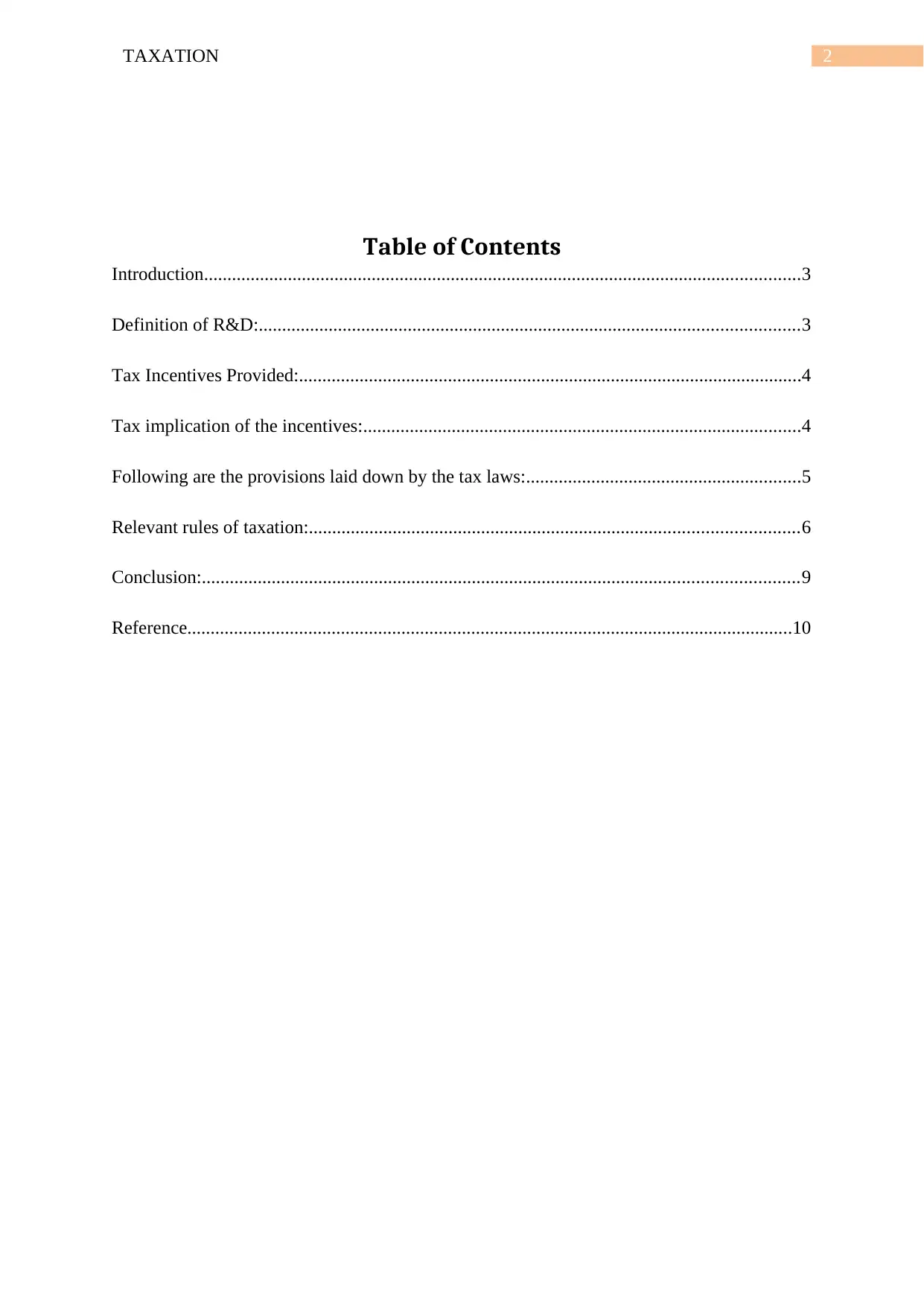
2TAXATION
Table of Contents
Introduction................................................................................................................................3
Definition of R&D:....................................................................................................................3
Tax Incentives Provided:............................................................................................................4
Tax implication of the incentives:..............................................................................................4
Following are the provisions laid down by the tax laws:...........................................................5
Relevant rules of taxation:.........................................................................................................6
Conclusion:................................................................................................................................9
Reference..................................................................................................................................10
Table of Contents
Introduction................................................................................................................................3
Definition of R&D:....................................................................................................................3
Tax Incentives Provided:............................................................................................................4
Tax implication of the incentives:..............................................................................................4
Following are the provisions laid down by the tax laws:...........................................................5
Relevant rules of taxation:.........................................................................................................6
Conclusion:................................................................................................................................9
Reference..................................................................................................................................10
⊘ This is a preview!⊘
Do you want full access?
Subscribe today to unlock all pages.

Trusted by 1+ million students worldwide
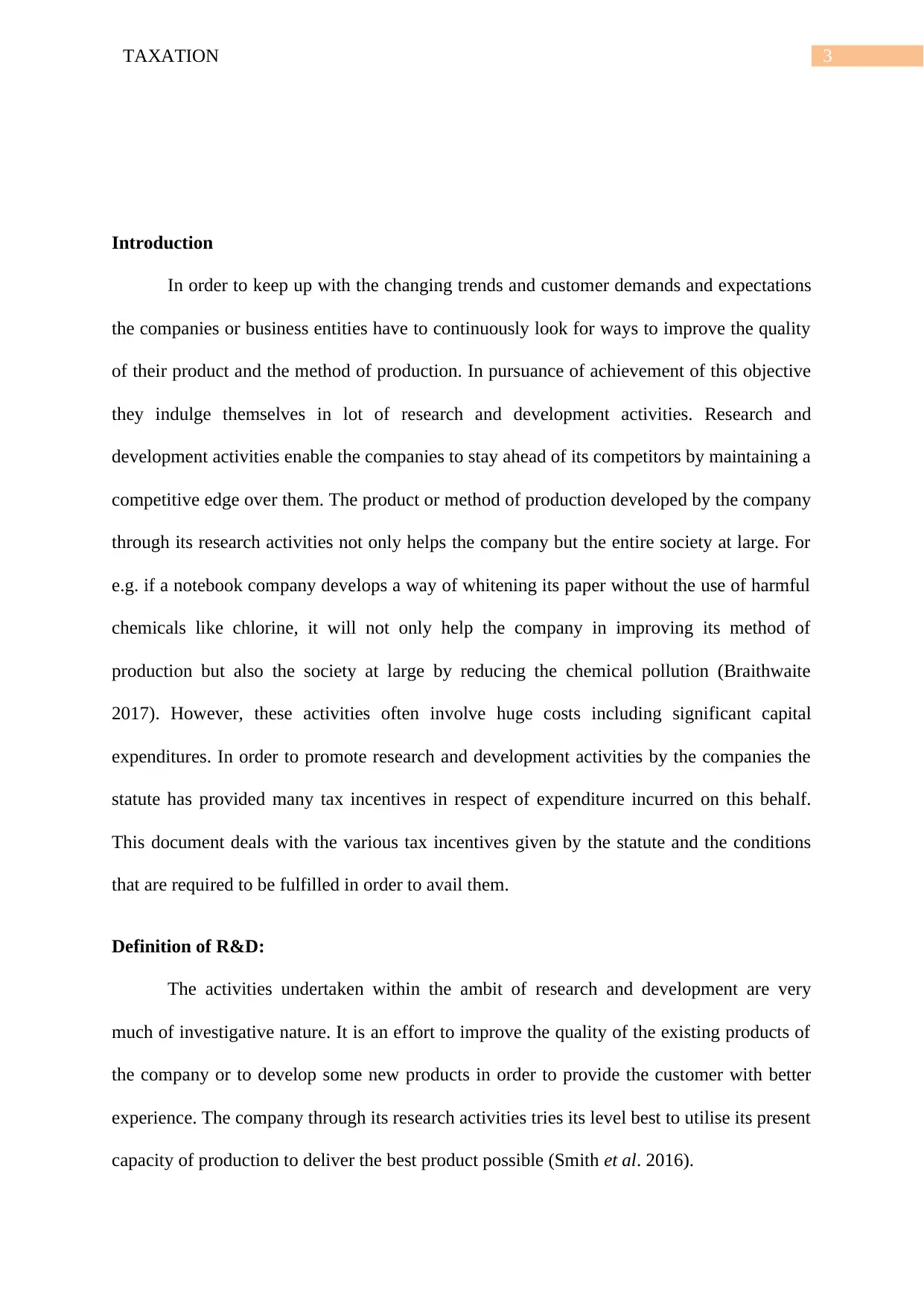
3TAXATION
Introduction
In order to keep up with the changing trends and customer demands and expectations
the companies or business entities have to continuously look for ways to improve the quality
of their product and the method of production. In pursuance of achievement of this objective
they indulge themselves in lot of research and development activities. Research and
development activities enable the companies to stay ahead of its competitors by maintaining a
competitive edge over them. The product or method of production developed by the company
through its research activities not only helps the company but the entire society at large. For
e.g. if a notebook company develops a way of whitening its paper without the use of harmful
chemicals like chlorine, it will not only help the company in improving its method of
production but also the society at large by reducing the chemical pollution (Braithwaite
2017). However, these activities often involve huge costs including significant capital
expenditures. In order to promote research and development activities by the companies the
statute has provided many tax incentives in respect of expenditure incurred on this behalf.
This document deals with the various tax incentives given by the statute and the conditions
that are required to be fulfilled in order to avail them.
Definition of R&D:
The activities undertaken within the ambit of research and development are very
much of investigative nature. It is an effort to improve the quality of the existing products of
the company or to develop some new products in order to provide the customer with better
experience. The company through its research activities tries its level best to utilise its present
capacity of production to deliver the best product possible (Smith et al. 2016).
Introduction
In order to keep up with the changing trends and customer demands and expectations
the companies or business entities have to continuously look for ways to improve the quality
of their product and the method of production. In pursuance of achievement of this objective
they indulge themselves in lot of research and development activities. Research and
development activities enable the companies to stay ahead of its competitors by maintaining a
competitive edge over them. The product or method of production developed by the company
through its research activities not only helps the company but the entire society at large. For
e.g. if a notebook company develops a way of whitening its paper without the use of harmful
chemicals like chlorine, it will not only help the company in improving its method of
production but also the society at large by reducing the chemical pollution (Braithwaite
2017). However, these activities often involve huge costs including significant capital
expenditures. In order to promote research and development activities by the companies the
statute has provided many tax incentives in respect of expenditure incurred on this behalf.
This document deals with the various tax incentives given by the statute and the conditions
that are required to be fulfilled in order to avail them.
Definition of R&D:
The activities undertaken within the ambit of research and development are very
much of investigative nature. It is an effort to improve the quality of the existing products of
the company or to develop some new products in order to provide the customer with better
experience. The company through its research activities tries its level best to utilise its present
capacity of production to deliver the best product possible (Smith et al. 2016).
Paraphrase This Document
Need a fresh take? Get an instant paraphrase of this document with our AI Paraphraser
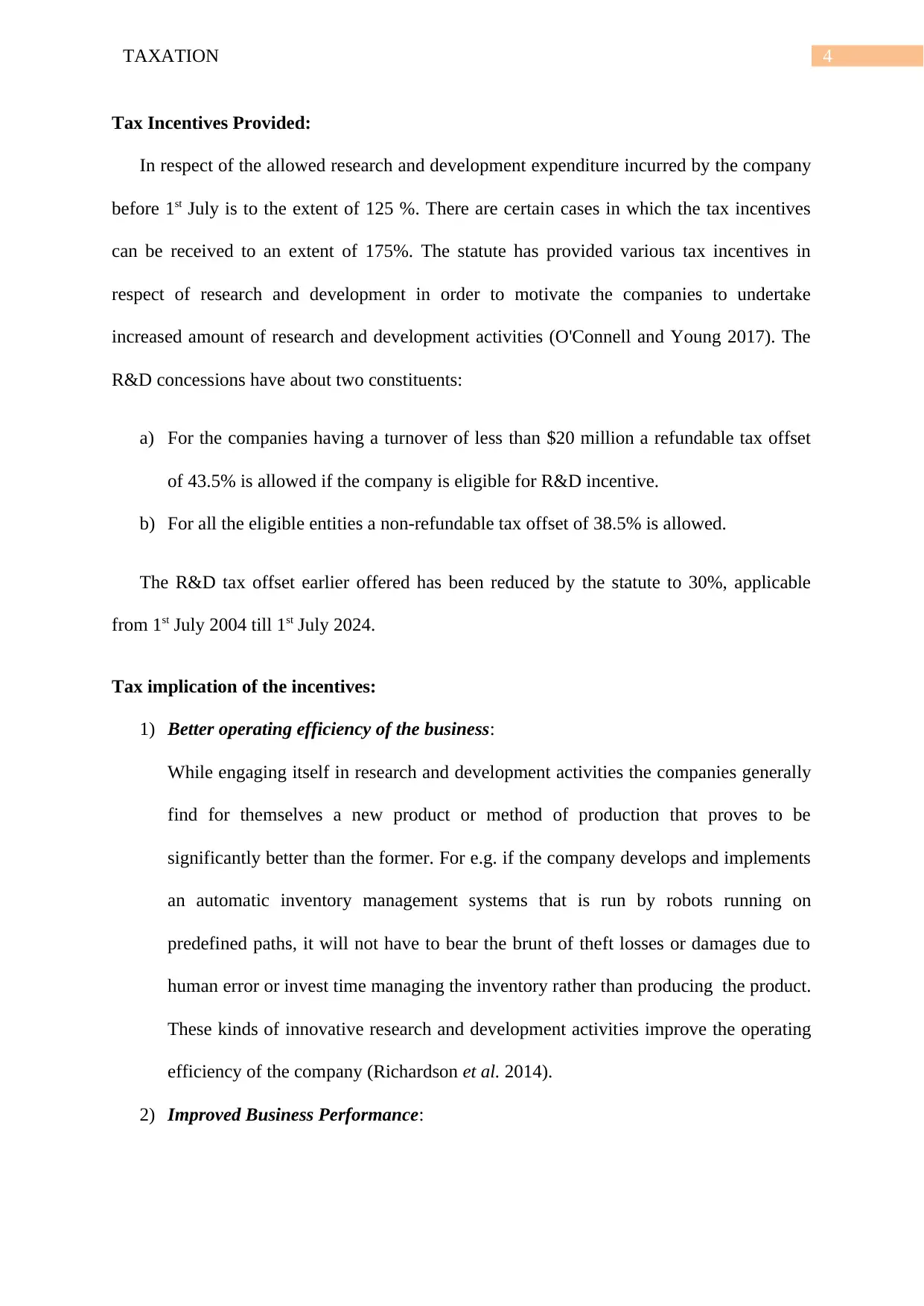
4TAXATION
Tax Incentives Provided:
In respect of the allowed research and development expenditure incurred by the company
before 1st July is to the extent of 125 %. There are certain cases in which the tax incentives
can be received to an extent of 175%. The statute has provided various tax incentives in
respect of research and development in order to motivate the companies to undertake
increased amount of research and development activities (O'Connell and Young 2017). The
R&D concessions have about two constituents:
a) For the companies having a turnover of less than $20 million a refundable tax offset
of 43.5% is allowed if the company is eligible for R&D incentive.
b) For all the eligible entities a non-refundable tax offset of 38.5% is allowed.
The R&D tax offset earlier offered has been reduced by the statute to 30%, applicable
from 1st July 2004 till 1st July 2024.
Tax implication of the incentives:
1) Better operating efficiency of the business:
While engaging itself in research and development activities the companies generally
find for themselves a new product or method of production that proves to be
significantly better than the former. For e.g. if the company develops and implements
an automatic inventory management systems that is run by robots running on
predefined paths, it will not have to bear the brunt of theft losses or damages due to
human error or invest time managing the inventory rather than producing the product.
These kinds of innovative research and development activities improve the operating
efficiency of the company (Richardson et al. 2014).
2) Improved Business Performance:
Tax Incentives Provided:
In respect of the allowed research and development expenditure incurred by the company
before 1st July is to the extent of 125 %. There are certain cases in which the tax incentives
can be received to an extent of 175%. The statute has provided various tax incentives in
respect of research and development in order to motivate the companies to undertake
increased amount of research and development activities (O'Connell and Young 2017). The
R&D concessions have about two constituents:
a) For the companies having a turnover of less than $20 million a refundable tax offset
of 43.5% is allowed if the company is eligible for R&D incentive.
b) For all the eligible entities a non-refundable tax offset of 38.5% is allowed.
The R&D tax offset earlier offered has been reduced by the statute to 30%, applicable
from 1st July 2004 till 1st July 2024.
Tax implication of the incentives:
1) Better operating efficiency of the business:
While engaging itself in research and development activities the companies generally
find for themselves a new product or method of production that proves to be
significantly better than the former. For e.g. if the company develops and implements
an automatic inventory management systems that is run by robots running on
predefined paths, it will not have to bear the brunt of theft losses or damages due to
human error or invest time managing the inventory rather than producing the product.
These kinds of innovative research and development activities improve the operating
efficiency of the company (Richardson et al. 2014).
2) Improved Business Performance:
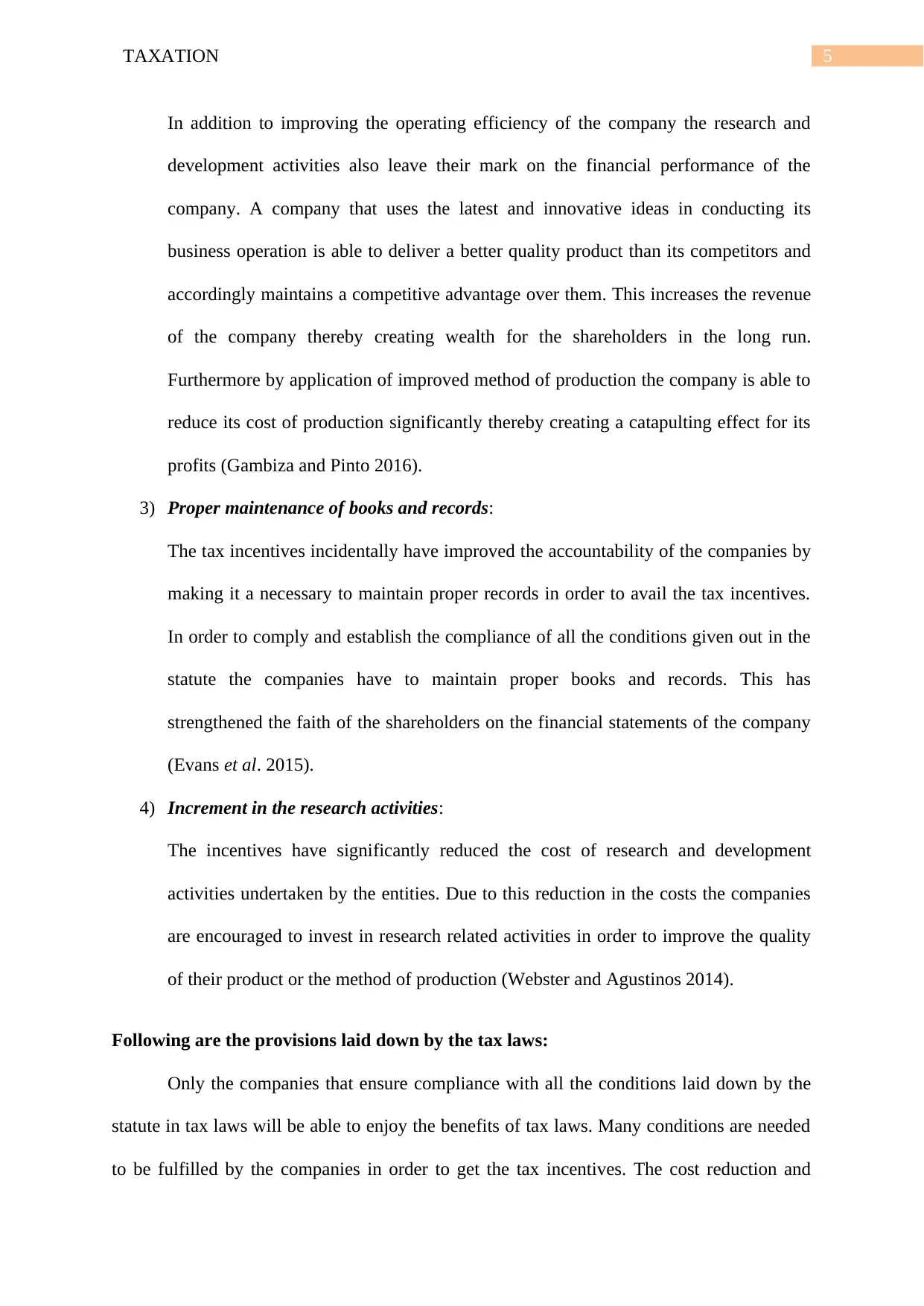
5TAXATION
In addition to improving the operating efficiency of the company the research and
development activities also leave their mark on the financial performance of the
company. A company that uses the latest and innovative ideas in conducting its
business operation is able to deliver a better quality product than its competitors and
accordingly maintains a competitive advantage over them. This increases the revenue
of the company thereby creating wealth for the shareholders in the long run.
Furthermore by application of improved method of production the company is able to
reduce its cost of production significantly thereby creating a catapulting effect for its
profits (Gambiza and Pinto 2016).
3) Proper maintenance of books and records:
The tax incentives incidentally have improved the accountability of the companies by
making it a necessary to maintain proper records in order to avail the tax incentives.
In order to comply and establish the compliance of all the conditions given out in the
statute the companies have to maintain proper books and records. This has
strengthened the faith of the shareholders on the financial statements of the company
(Evans et al. 2015).
4) Increment in the research activities:
The incentives have significantly reduced the cost of research and development
activities undertaken by the entities. Due to this reduction in the costs the companies
are encouraged to invest in research related activities in order to improve the quality
of their product or the method of production (Webster and Agustinos 2014).
Following are the provisions laid down by the tax laws:
Only the companies that ensure compliance with all the conditions laid down by the
statute in tax laws will be able to enjoy the benefits of tax laws. Many conditions are needed
to be fulfilled by the companies in order to get the tax incentives. The cost reduction and
In addition to improving the operating efficiency of the company the research and
development activities also leave their mark on the financial performance of the
company. A company that uses the latest and innovative ideas in conducting its
business operation is able to deliver a better quality product than its competitors and
accordingly maintains a competitive advantage over them. This increases the revenue
of the company thereby creating wealth for the shareholders in the long run.
Furthermore by application of improved method of production the company is able to
reduce its cost of production significantly thereby creating a catapulting effect for its
profits (Gambiza and Pinto 2016).
3) Proper maintenance of books and records:
The tax incentives incidentally have improved the accountability of the companies by
making it a necessary to maintain proper records in order to avail the tax incentives.
In order to comply and establish the compliance of all the conditions given out in the
statute the companies have to maintain proper books and records. This has
strengthened the faith of the shareholders on the financial statements of the company
(Evans et al. 2015).
4) Increment in the research activities:
The incentives have significantly reduced the cost of research and development
activities undertaken by the entities. Due to this reduction in the costs the companies
are encouraged to invest in research related activities in order to improve the quality
of their product or the method of production (Webster and Agustinos 2014).
Following are the provisions laid down by the tax laws:
Only the companies that ensure compliance with all the conditions laid down by the
statute in tax laws will be able to enjoy the benefits of tax laws. Many conditions are needed
to be fulfilled by the companies in order to get the tax incentives. The cost reduction and
⊘ This is a preview!⊘
Do you want full access?
Subscribe today to unlock all pages.

Trusted by 1+ million students worldwide
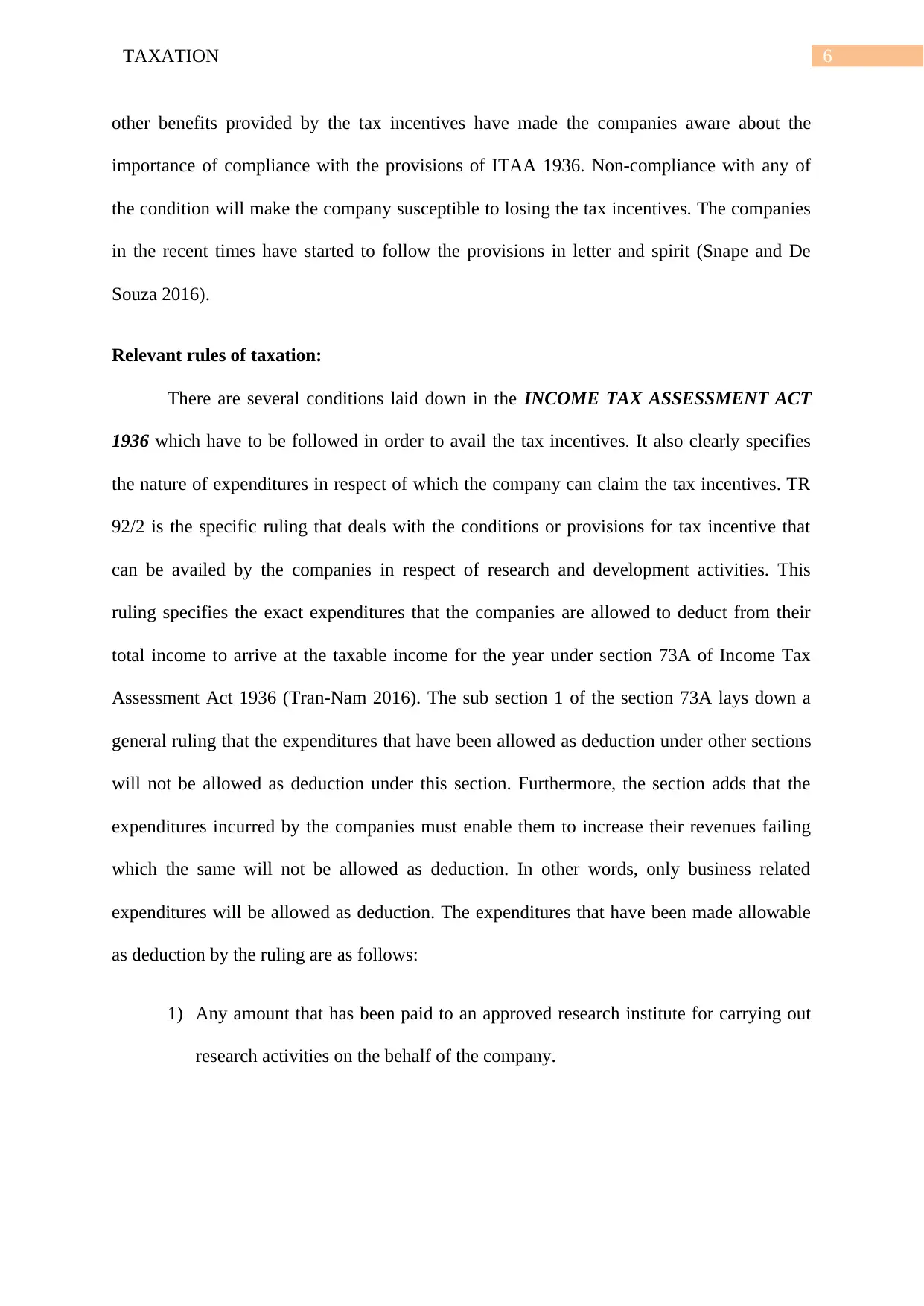
6TAXATION
other benefits provided by the tax incentives have made the companies aware about the
importance of compliance with the provisions of ITAA 1936. Non-compliance with any of
the condition will make the company susceptible to losing the tax incentives. The companies
in the recent times have started to follow the provisions in letter and spirit (Snape and De
Souza 2016).
Relevant rules of taxation:
There are several conditions laid down in the INCOME TAX ASSESSMENT ACT
1936 which have to be followed in order to avail the tax incentives. It also clearly specifies
the nature of expenditures in respect of which the company can claim the tax incentives. TR
92/2 is the specific ruling that deals with the conditions or provisions for tax incentive that
can be availed by the companies in respect of research and development activities. This
ruling specifies the exact expenditures that the companies are allowed to deduct from their
total income to arrive at the taxable income for the year under section 73A of Income Tax
Assessment Act 1936 (Tran-Nam 2016). The sub section 1 of the section 73A lays down a
general ruling that the expenditures that have been allowed as deduction under other sections
will not be allowed as deduction under this section. Furthermore, the section adds that the
expenditures incurred by the companies must enable them to increase their revenues failing
which the same will not be allowed as deduction. In other words, only business related
expenditures will be allowed as deduction. The expenditures that have been made allowable
as deduction by the ruling are as follows:
1) Any amount that has been paid to an approved research institute for carrying out
research activities on the behalf of the company.
other benefits provided by the tax incentives have made the companies aware about the
importance of compliance with the provisions of ITAA 1936. Non-compliance with any of
the condition will make the company susceptible to losing the tax incentives. The companies
in the recent times have started to follow the provisions in letter and spirit (Snape and De
Souza 2016).
Relevant rules of taxation:
There are several conditions laid down in the INCOME TAX ASSESSMENT ACT
1936 which have to be followed in order to avail the tax incentives. It also clearly specifies
the nature of expenditures in respect of which the company can claim the tax incentives. TR
92/2 is the specific ruling that deals with the conditions or provisions for tax incentive that
can be availed by the companies in respect of research and development activities. This
ruling specifies the exact expenditures that the companies are allowed to deduct from their
total income to arrive at the taxable income for the year under section 73A of Income Tax
Assessment Act 1936 (Tran-Nam 2016). The sub section 1 of the section 73A lays down a
general ruling that the expenditures that have been allowed as deduction under other sections
will not be allowed as deduction under this section. Furthermore, the section adds that the
expenditures incurred by the companies must enable them to increase their revenues failing
which the same will not be allowed as deduction. In other words, only business related
expenditures will be allowed as deduction. The expenditures that have been made allowable
as deduction by the ruling are as follows:
1) Any amount that has been paid to an approved research institute for carrying out
research activities on the behalf of the company.
Paraphrase This Document
Need a fresh take? Get an instant paraphrase of this document with our AI Paraphraser
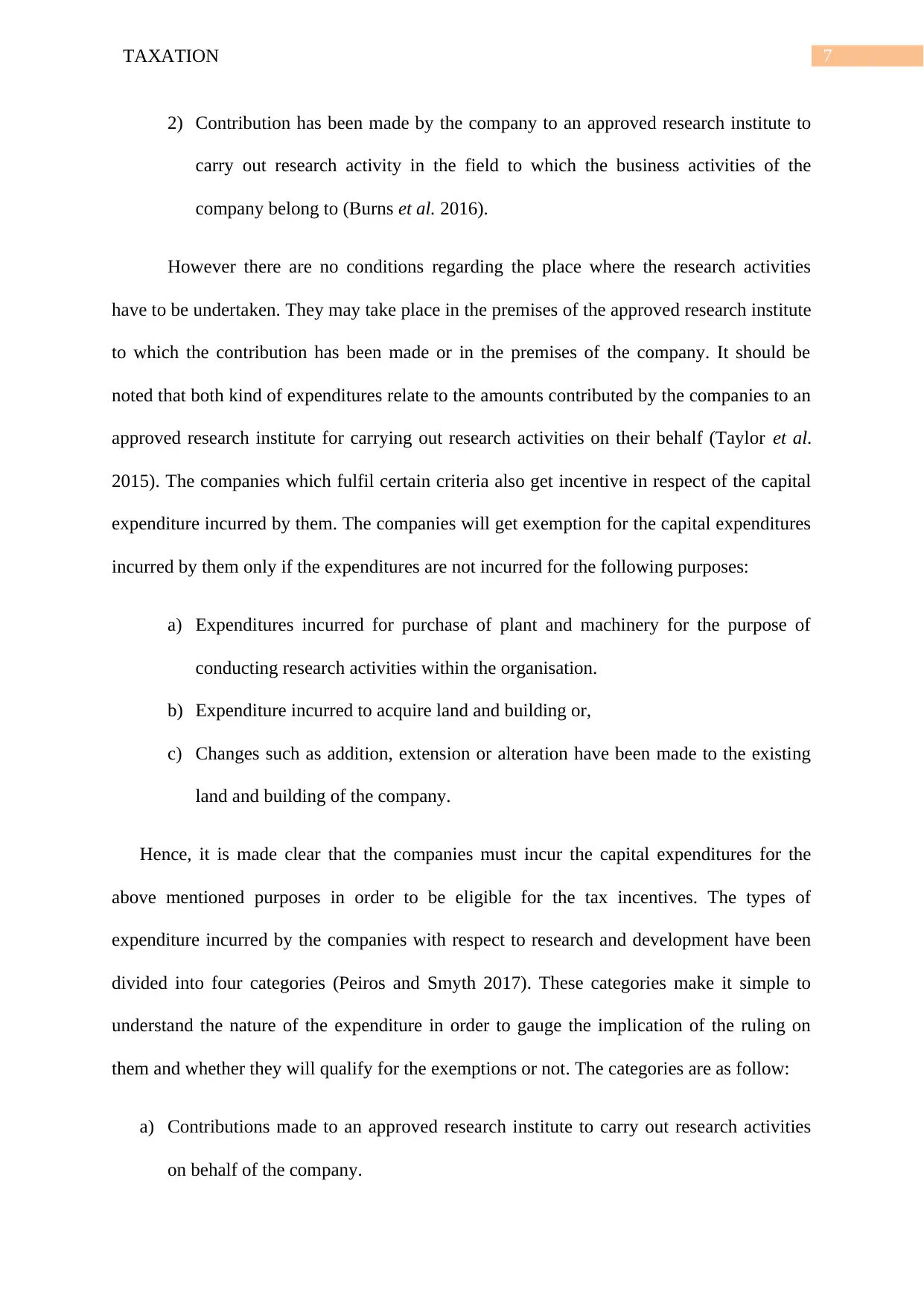
7TAXATION
2) Contribution has been made by the company to an approved research institute to
carry out research activity in the field to which the business activities of the
company belong to (Burns et al. 2016).
However there are no conditions regarding the place where the research activities
have to be undertaken. They may take place in the premises of the approved research institute
to which the contribution has been made or in the premises of the company. It should be
noted that both kind of expenditures relate to the amounts contributed by the companies to an
approved research institute for carrying out research activities on their behalf (Taylor et al.
2015). The companies which fulfil certain criteria also get incentive in respect of the capital
expenditure incurred by them. The companies will get exemption for the capital expenditures
incurred by them only if the expenditures are not incurred for the following purposes:
a) Expenditures incurred for purchase of plant and machinery for the purpose of
conducting research activities within the organisation.
b) Expenditure incurred to acquire land and building or,
c) Changes such as addition, extension or alteration have been made to the existing
land and building of the company.
Hence, it is made clear that the companies must incur the capital expenditures for the
above mentioned purposes in order to be eligible for the tax incentives. The types of
expenditure incurred by the companies with respect to research and development have been
divided into four categories (Peiros and Smyth 2017). These categories make it simple to
understand the nature of the expenditure in order to gauge the implication of the ruling on
them and whether they will qualify for the exemptions or not. The categories are as follow:
a) Contributions made to an approved research institute to carry out research activities
on behalf of the company.
2) Contribution has been made by the company to an approved research institute to
carry out research activity in the field to which the business activities of the
company belong to (Burns et al. 2016).
However there are no conditions regarding the place where the research activities
have to be undertaken. They may take place in the premises of the approved research institute
to which the contribution has been made or in the premises of the company. It should be
noted that both kind of expenditures relate to the amounts contributed by the companies to an
approved research institute for carrying out research activities on their behalf (Taylor et al.
2015). The companies which fulfil certain criteria also get incentive in respect of the capital
expenditure incurred by them. The companies will get exemption for the capital expenditures
incurred by them only if the expenditures are not incurred for the following purposes:
a) Expenditures incurred for purchase of plant and machinery for the purpose of
conducting research activities within the organisation.
b) Expenditure incurred to acquire land and building or,
c) Changes such as addition, extension or alteration have been made to the existing
land and building of the company.
Hence, it is made clear that the companies must incur the capital expenditures for the
above mentioned purposes in order to be eligible for the tax incentives. The types of
expenditure incurred by the companies with respect to research and development have been
divided into four categories (Peiros and Smyth 2017). These categories make it simple to
understand the nature of the expenditure in order to gauge the implication of the ruling on
them and whether they will qualify for the exemptions or not. The categories are as follow:
a) Contributions made to an approved research institute to carry out research activities
on behalf of the company.
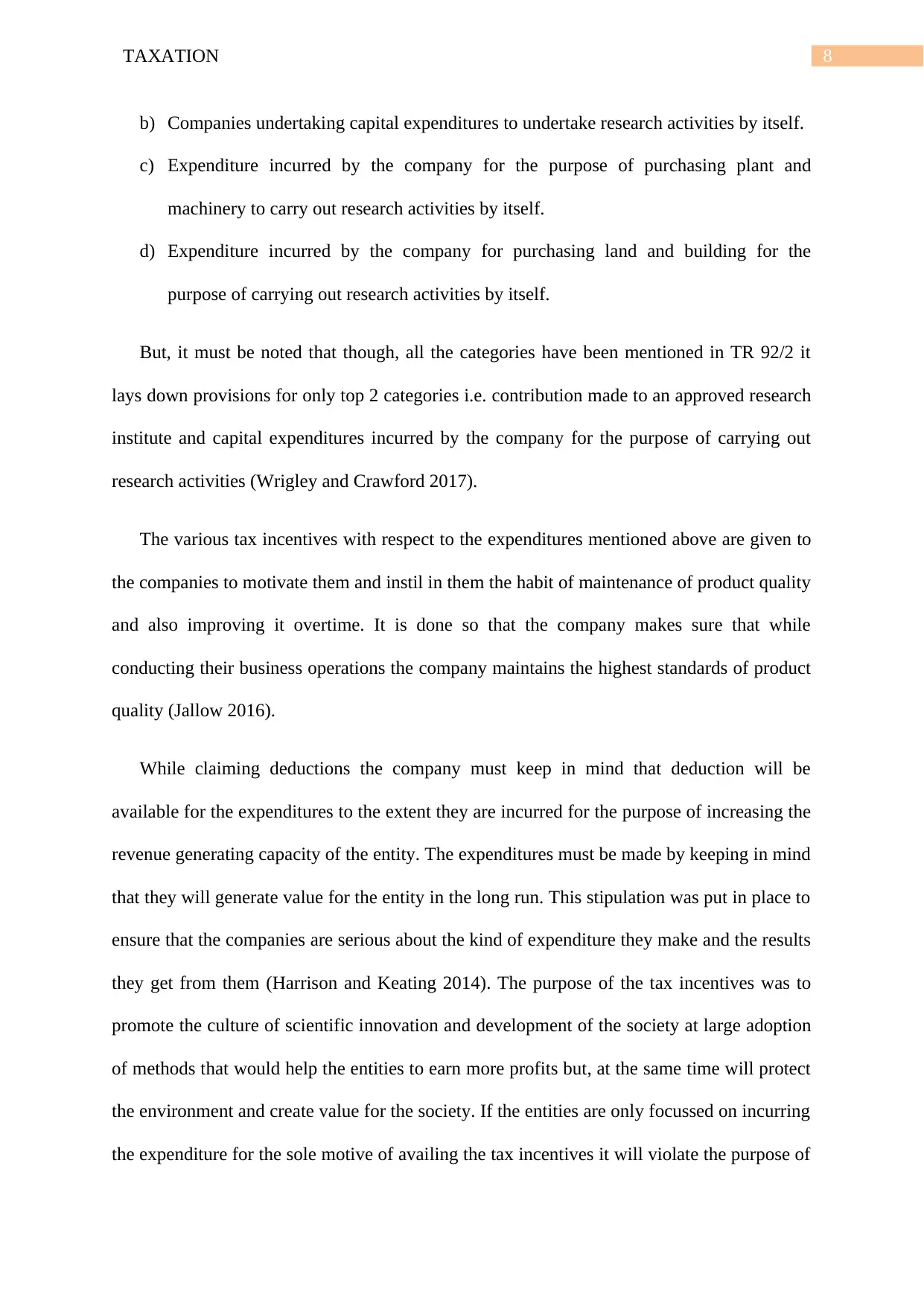
8TAXATION
b) Companies undertaking capital expenditures to undertake research activities by itself.
c) Expenditure incurred by the company for the purpose of purchasing plant and
machinery to carry out research activities by itself.
d) Expenditure incurred by the company for purchasing land and building for the
purpose of carrying out research activities by itself.
But, it must be noted that though, all the categories have been mentioned in TR 92/2 it
lays down provisions for only top 2 categories i.e. contribution made to an approved research
institute and capital expenditures incurred by the company for the purpose of carrying out
research activities (Wrigley and Crawford 2017).
The various tax incentives with respect to the expenditures mentioned above are given to
the companies to motivate them and instil in them the habit of maintenance of product quality
and also improving it overtime. It is done so that the company makes sure that while
conducting their business operations the company maintains the highest standards of product
quality (Jallow 2016).
While claiming deductions the company must keep in mind that deduction will be
available for the expenditures to the extent they are incurred for the purpose of increasing the
revenue generating capacity of the entity. The expenditures must be made by keeping in mind
that they will generate value for the entity in the long run. This stipulation was put in place to
ensure that the companies are serious about the kind of expenditure they make and the results
they get from them (Harrison and Keating 2014). The purpose of the tax incentives was to
promote the culture of scientific innovation and development of the society at large adoption
of methods that would help the entities to earn more profits but, at the same time will protect
the environment and create value for the society. If the entities are only focussed on incurring
the expenditure for the sole motive of availing the tax incentives it will violate the purpose of
b) Companies undertaking capital expenditures to undertake research activities by itself.
c) Expenditure incurred by the company for the purpose of purchasing plant and
machinery to carry out research activities by itself.
d) Expenditure incurred by the company for purchasing land and building for the
purpose of carrying out research activities by itself.
But, it must be noted that though, all the categories have been mentioned in TR 92/2 it
lays down provisions for only top 2 categories i.e. contribution made to an approved research
institute and capital expenditures incurred by the company for the purpose of carrying out
research activities (Wrigley and Crawford 2017).
The various tax incentives with respect to the expenditures mentioned above are given to
the companies to motivate them and instil in them the habit of maintenance of product quality
and also improving it overtime. It is done so that the company makes sure that while
conducting their business operations the company maintains the highest standards of product
quality (Jallow 2016).
While claiming deductions the company must keep in mind that deduction will be
available for the expenditures to the extent they are incurred for the purpose of increasing the
revenue generating capacity of the entity. The expenditures must be made by keeping in mind
that they will generate value for the entity in the long run. This stipulation was put in place to
ensure that the companies are serious about the kind of expenditure they make and the results
they get from them (Harrison and Keating 2014). The purpose of the tax incentives was to
promote the culture of scientific innovation and development of the society at large adoption
of methods that would help the entities to earn more profits but, at the same time will protect
the environment and create value for the society. If the entities are only focussed on incurring
the expenditure for the sole motive of availing the tax incentives it will violate the purpose of
⊘ This is a preview!⊘
Do you want full access?
Subscribe today to unlock all pages.

Trusted by 1+ million students worldwide
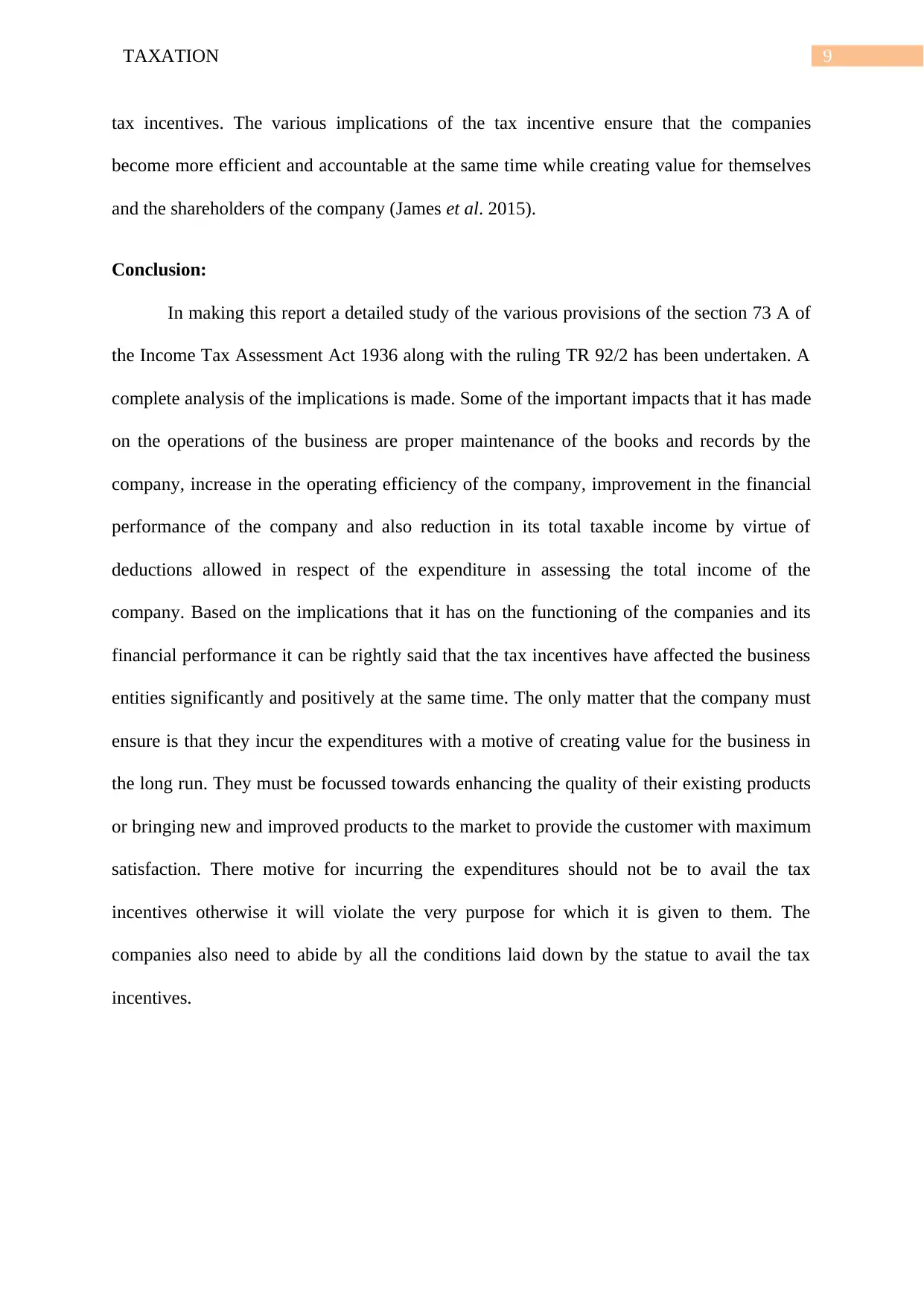
9TAXATION
tax incentives. The various implications of the tax incentive ensure that the companies
become more efficient and accountable at the same time while creating value for themselves
and the shareholders of the company (James et al. 2015).
Conclusion:
In making this report a detailed study of the various provisions of the section 73 A of
the Income Tax Assessment Act 1936 along with the ruling TR 92/2 has been undertaken. A
complete analysis of the implications is made. Some of the important impacts that it has made
on the operations of the business are proper maintenance of the books and records by the
company, increase in the operating efficiency of the company, improvement in the financial
performance of the company and also reduction in its total taxable income by virtue of
deductions allowed in respect of the expenditure in assessing the total income of the
company. Based on the implications that it has on the functioning of the companies and its
financial performance it can be rightly said that the tax incentives have affected the business
entities significantly and positively at the same time. The only matter that the company must
ensure is that they incur the expenditures with a motive of creating value for the business in
the long run. They must be focussed towards enhancing the quality of their existing products
or bringing new and improved products to the market to provide the customer with maximum
satisfaction. There motive for incurring the expenditures should not be to avail the tax
incentives otherwise it will violate the very purpose for which it is given to them. The
companies also need to abide by all the conditions laid down by the statue to avail the tax
incentives.
tax incentives. The various implications of the tax incentive ensure that the companies
become more efficient and accountable at the same time while creating value for themselves
and the shareholders of the company (James et al. 2015).
Conclusion:
In making this report a detailed study of the various provisions of the section 73 A of
the Income Tax Assessment Act 1936 along with the ruling TR 92/2 has been undertaken. A
complete analysis of the implications is made. Some of the important impacts that it has made
on the operations of the business are proper maintenance of the books and records by the
company, increase in the operating efficiency of the company, improvement in the financial
performance of the company and also reduction in its total taxable income by virtue of
deductions allowed in respect of the expenditure in assessing the total income of the
company. Based on the implications that it has on the functioning of the companies and its
financial performance it can be rightly said that the tax incentives have affected the business
entities significantly and positively at the same time. The only matter that the company must
ensure is that they incur the expenditures with a motive of creating value for the business in
the long run. They must be focussed towards enhancing the quality of their existing products
or bringing new and improved products to the market to provide the customer with maximum
satisfaction. There motive for incurring the expenditures should not be to avail the tax
incentives otherwise it will violate the very purpose for which it is given to them. The
companies also need to abide by all the conditions laid down by the statue to avail the tax
incentives.
Paraphrase This Document
Need a fresh take? Get an instant paraphrase of this document with our AI Paraphraser
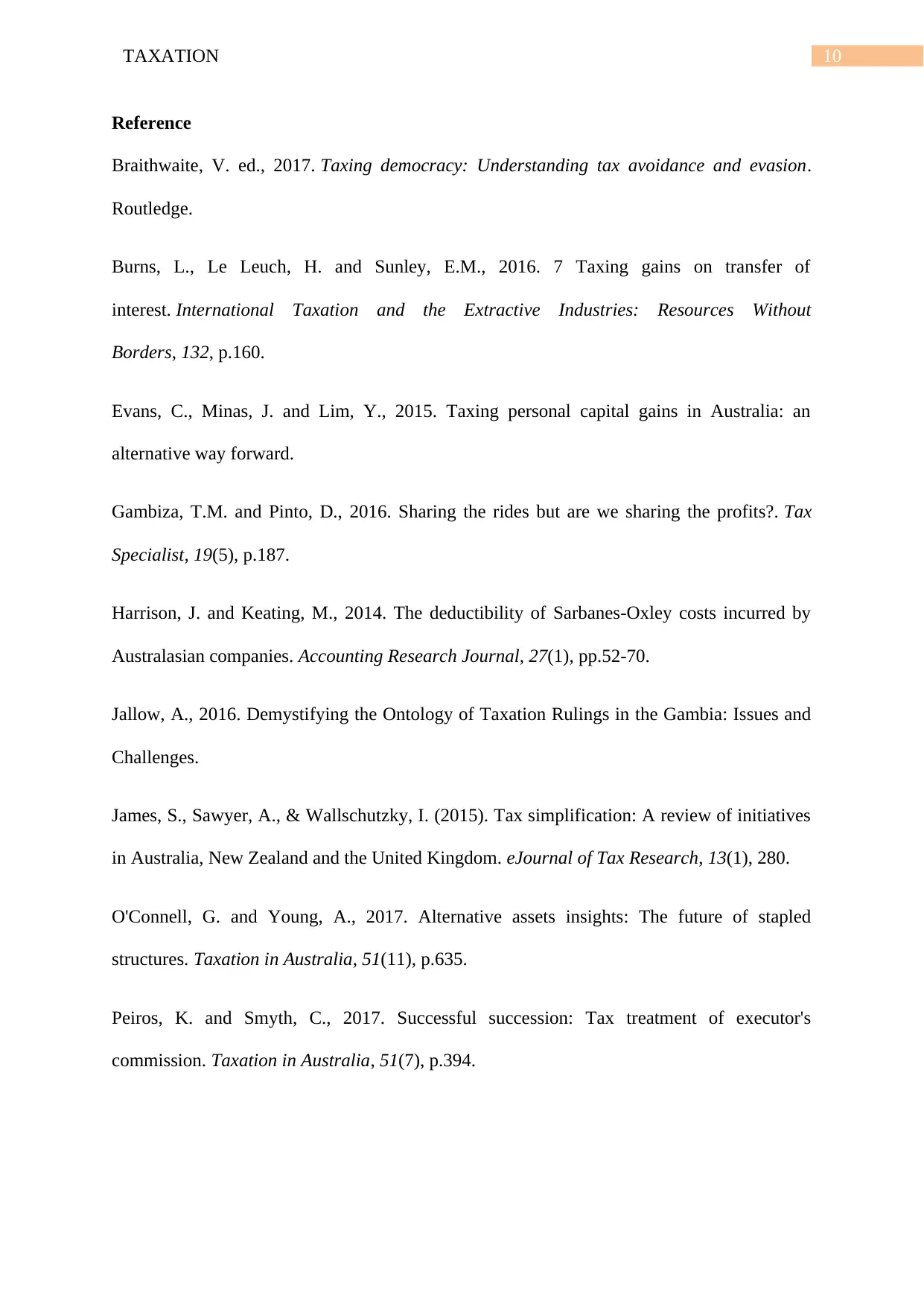
10TAXATION
Reference
Braithwaite, V. ed., 2017. Taxing democracy: Understanding tax avoidance and evasion.
Routledge.
Burns, L., Le Leuch, H. and Sunley, E.M., 2016. 7 Taxing gains on transfer of
interest. International Taxation and the Extractive Industries: Resources Without
Borders, 132, p.160.
Evans, C., Minas, J. and Lim, Y., 2015. Taxing personal capital gains in Australia: an
alternative way forward.
Gambiza, T.M. and Pinto, D., 2016. Sharing the rides but are we sharing the profits?. Tax
Specialist, 19(5), p.187.
Harrison, J. and Keating, M., 2014. The deductibility of Sarbanes-Oxley costs incurred by
Australasian companies. Accounting Research Journal, 27(1), pp.52-70.
Jallow, A., 2016. Demystifying the Ontology of Taxation Rulings in the Gambia: Issues and
Challenges.
James, S., Sawyer, A., & Wallschutzky, I. (2015). Tax simplification: A review of initiatives
in Australia, New Zealand and the United Kingdom. eJournal of Tax Research, 13(1), 280.
O'Connell, G. and Young, A., 2017. Alternative assets insights: The future of stapled
structures. Taxation in Australia, 51(11), p.635.
Peiros, K. and Smyth, C., 2017. Successful succession: Tax treatment of executor's
commission. Taxation in Australia, 51(7), p.394.
Reference
Braithwaite, V. ed., 2017. Taxing democracy: Understanding tax avoidance and evasion.
Routledge.
Burns, L., Le Leuch, H. and Sunley, E.M., 2016. 7 Taxing gains on transfer of
interest. International Taxation and the Extractive Industries: Resources Without
Borders, 132, p.160.
Evans, C., Minas, J. and Lim, Y., 2015. Taxing personal capital gains in Australia: an
alternative way forward.
Gambiza, T.M. and Pinto, D., 2016. Sharing the rides but are we sharing the profits?. Tax
Specialist, 19(5), p.187.
Harrison, J. and Keating, M., 2014. The deductibility of Sarbanes-Oxley costs incurred by
Australasian companies. Accounting Research Journal, 27(1), pp.52-70.
Jallow, A., 2016. Demystifying the Ontology of Taxation Rulings in the Gambia: Issues and
Challenges.
James, S., Sawyer, A., & Wallschutzky, I. (2015). Tax simplification: A review of initiatives
in Australia, New Zealand and the United Kingdom. eJournal of Tax Research, 13(1), 280.
O'Connell, G. and Young, A., 2017. Alternative assets insights: The future of stapled
structures. Taxation in Australia, 51(11), p.635.
Peiros, K. and Smyth, C., 2017. Successful succession: Tax treatment of executor's
commission. Taxation in Australia, 51(7), p.394.
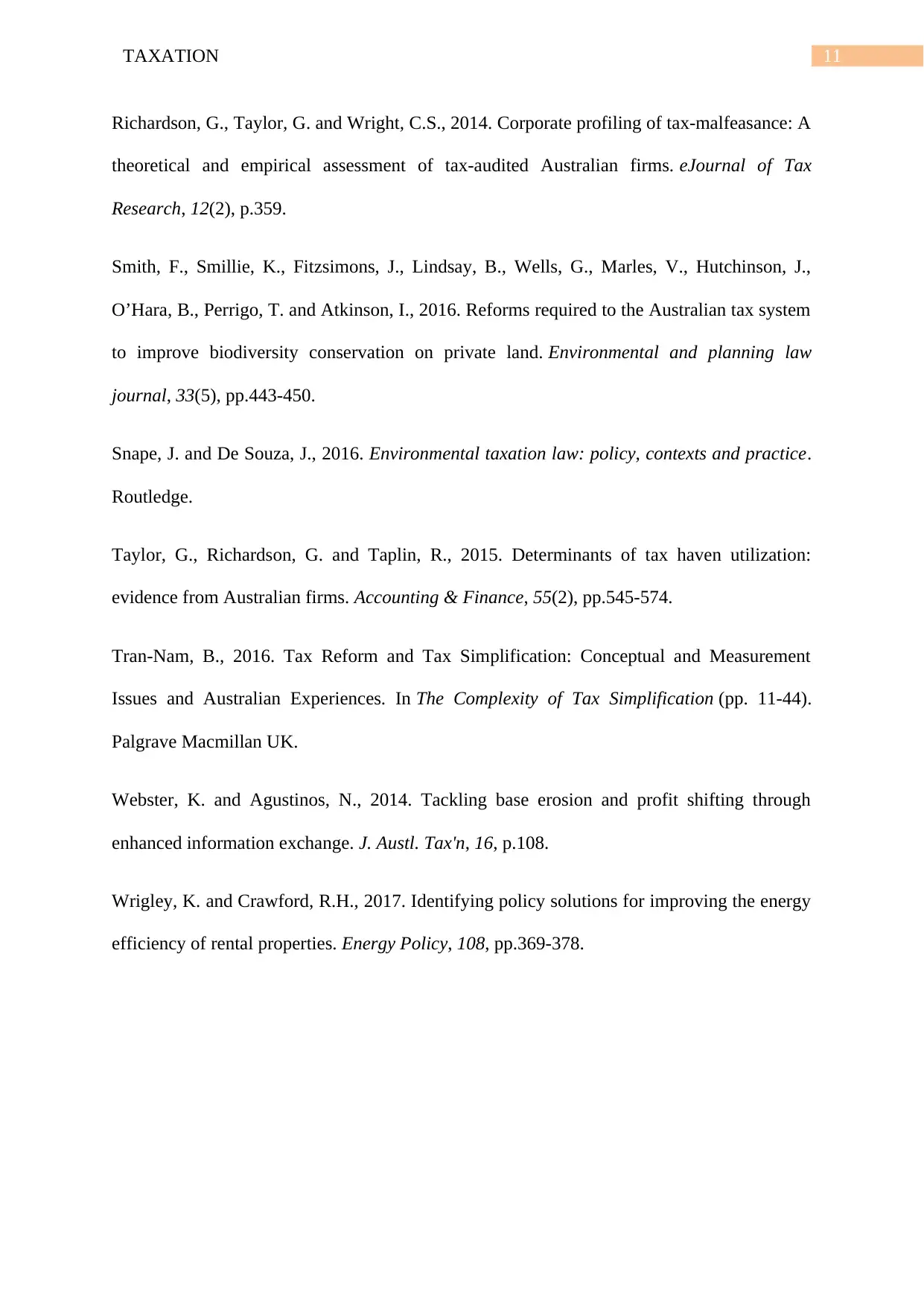
11TAXATION
Richardson, G., Taylor, G. and Wright, C.S., 2014. Corporate profiling of tax-malfeasance: A
theoretical and empirical assessment of tax-audited Australian firms. eJournal of Tax
Research, 12(2), p.359.
Smith, F., Smillie, K., Fitzsimons, J., Lindsay, B., Wells, G., Marles, V., Hutchinson, J.,
O’Hara, B., Perrigo, T. and Atkinson, I., 2016. Reforms required to the Australian tax system
to improve biodiversity conservation on private land. Environmental and planning law
journal, 33(5), pp.443-450.
Snape, J. and De Souza, J., 2016. Environmental taxation law: policy, contexts and practice.
Routledge.
Taylor, G., Richardson, G. and Taplin, R., 2015. Determinants of tax haven utilization:
evidence from Australian firms. Accounting & Finance, 55(2), pp.545-574.
Tran-Nam, B., 2016. Tax Reform and Tax Simplification: Conceptual and Measurement
Issues and Australian Experiences. In The Complexity of Tax Simplification (pp. 11-44).
Palgrave Macmillan UK.
Webster, K. and Agustinos, N., 2014. Tackling base erosion and profit shifting through
enhanced information exchange. J. Austl. Tax'n, 16, p.108.
Wrigley, K. and Crawford, R.H., 2017. Identifying policy solutions for improving the energy
efficiency of rental properties. Energy Policy, 108, pp.369-378.
Richardson, G., Taylor, G. and Wright, C.S., 2014. Corporate profiling of tax-malfeasance: A
theoretical and empirical assessment of tax-audited Australian firms. eJournal of Tax
Research, 12(2), p.359.
Smith, F., Smillie, K., Fitzsimons, J., Lindsay, B., Wells, G., Marles, V., Hutchinson, J.,
O’Hara, B., Perrigo, T. and Atkinson, I., 2016. Reforms required to the Australian tax system
to improve biodiversity conservation on private land. Environmental and planning law
journal, 33(5), pp.443-450.
Snape, J. and De Souza, J., 2016. Environmental taxation law: policy, contexts and practice.
Routledge.
Taylor, G., Richardson, G. and Taplin, R., 2015. Determinants of tax haven utilization:
evidence from Australian firms. Accounting & Finance, 55(2), pp.545-574.
Tran-Nam, B., 2016. Tax Reform and Tax Simplification: Conceptual and Measurement
Issues and Australian Experiences. In The Complexity of Tax Simplification (pp. 11-44).
Palgrave Macmillan UK.
Webster, K. and Agustinos, N., 2014. Tackling base erosion and profit shifting through
enhanced information exchange. J. Austl. Tax'n, 16, p.108.
Wrigley, K. and Crawford, R.H., 2017. Identifying policy solutions for improving the energy
efficiency of rental properties. Energy Policy, 108, pp.369-378.
⊘ This is a preview!⊘
Do you want full access?
Subscribe today to unlock all pages.

Trusted by 1+ million students worldwide
1 out of 12
Related Documents
Your All-in-One AI-Powered Toolkit for Academic Success.
+13062052269
info@desklib.com
Available 24*7 on WhatsApp / Email
![[object Object]](/_next/static/media/star-bottom.7253800d.svg)
Unlock your academic potential
Copyright © 2020–2025 A2Z Services. All Rights Reserved. Developed and managed by ZUCOL.





